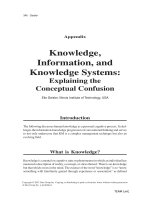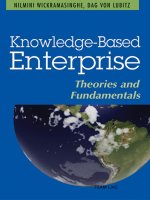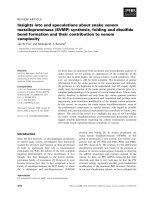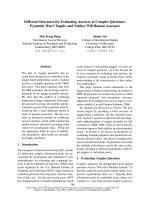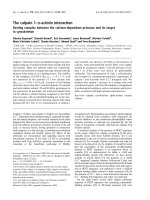Reasoning about complex agent knowledge ontologies, uncertainty, rules and beyond
Bạn đang xem bản rút gọn của tài liệu. Xem và tải ngay bản đầy đủ của tài liệu tại đây (1.13 MB, 212 trang )
REASONING ABOUT COMPLEX AGENT KNOWLEDGE
ONTOLOGIES, UNCERTAINTY, RULES AND BEYOND
YUZHANG FENG
B.Sc.(Hons). NUS
A THESIS SUBMITTED
FOR THE DEGREE OF DOCTOR OF PHILOSOPHY
DEPARTMENT OF COMPUTER SCIENCE
SCHOOL OF COMPUTING
NATIONAL UNIVERSITY OF SINGAPORE
2010
Acknowledgement
I would like to take this opportunity to express my sincere gratitude to those who
assisted me, in one way or another, with my Ph.D.
First and foremost, I would like to thank my Honor’s Year Project and Ph.D. advisor
Dr. Dong Jin Song and co-advisor Dr. Daqing Zhang for their never-ending enthu-
siasm, guidance, support, encouragement and insight throughout the course of my
postgraduate study. Their diligent reading and insightful and constructive criticism
of early drafts and many other works made this thesis possible.
I am grateful to Prof. Tan Chew Lim and Prof. Rudy Setiono for the critical com-
ments on this thesis. I am also thankful to the external reviewer and numerous
anonymous referees who have reviewed this thesis and previous publications that are
parts of this thesis and their valuable comments have contributed to the clarification
of many ideas presented in this thesis.
This thesis was in part funded by the projects “Formal Design Methods and DAML”
and “Advanced Ontological Rules Language and Tools” supported by the Defence Sci-
ence and Technology Agency of Singapore, “Rigorous Design Methods and Tools for
Intelligent Autonomous Multi-Agent Systems” supported by Ministry of Education
of Singapore, and “Systematic Design Methods and Tools for Developing Location
Aware, Mobile and Pervasive Computing Systems” supported by the Media Devel-
opment Authority of Singapore. My gratitude also goes to National University of
Singapore for the generous financial support, in forms of scholarship and conference
travel allowance.
I also wish to thank my seniors, Dr. Sun Jun, Dr. Chen Chunqing, and my cousin
Dr. Li Yuan-Fang for their friendship, collaboration and generous sharing of research
experience. I am also lucky to have my former and current lab mates from the formal
methods group for their friendship and funny chit chat which helped me go through
the long and sometimes rough way of Ph.D. study.
I wish to thank sincerely and deeply my parents who have raised me, taught me and
supported me all these years and who always have faith in me.
I owe thanks to my beloved wife Hao Na. I would not have completed my thesis
without your ceaseless love, encouragement and patience. Lastly I would like to
dedicate this thesis to my lovely newborn daughter Yuanxin.
Contents
1 Introduction 1
1.1 Motivations and Goals . . . . . . . . . . . . . . . . . . . . . . . . . . 1
1.2 Thesis Outline . . . . . . . . . . . . . . . . . . . . . . . . . . . . . . . 5
1.2.1 Chapter 2 - Background Overview . . . . . . . . . . . . . . . . 5
1.2.2 Chapter 3 - Checking Ontology-based Agent Knowledge . . . . 6
1.2.3 Chapter 4 - Checking Agent Knowledge With Uncertainty . . 7
1.2.4 Chapter 5 - Checking Rule-based Agent Knowledge . . . . . . 8
1.2.5 Chapter 6 - Checking Higher-order Agent Knowledge . . . . . 8
1.2.6 Chapter 7 - Conclusion . . . . . . . . . . . . . . . . . . . . . . 9
1.3 Publications . . . . . . . . . . . . . . . . . . . . . . . . . . . . . . . . 9
2 Background Overview 11
2.1 Semantic Web . . . . . . . . . . . . . . . . . . . . . . . . . . . . . . . 11
2.1.1 Semantic Web Languages . . . . . . . . . . . . . . . . . . . . 12
2.1.2 Semantic Web Reasoners . . . . . . . . . . . . . . . . . . . . . 15
2.2 Prototype Verification System . . . . . . . . . . . . . . . . . . . . . . 17
2.3 Constraint Logic Programming . . . . . . . . . . . . . . . . . . . . . 19
iii
CONTENTS iv
3 Checking Ontology-based Agent Knowledge 23
3.1 PVS Semantics for OWL DL . . . . . . . . . . . . . . . . . . . . . . . 25
3.1.1 Basic Concepts . . . . . . . . . . . . . . . . . . . . . . . . . . 25
3.1.2 Class Descriptions . . . . . . . . . . . . . . . . . . . . . . . . 28
3.1.3 Axioms . . . . . . . . . . . . . . . . . . . . . . . . . . . . . . 36
3.1.4 Assertions . . . . . . . . . . . . . . . . . . . . . . . . . . . . . 41
3.1.5 SWRL Rules . . . . . . . . . . . . . . . . . . . . . . . . . . . 42
3.1.6 Proof Support for PVS . . . . . . . . . . . . . . . . . . . . . . 43
3.2 Reasoning about Ontologies in PVS . . . . . . . . . . . . . . . . . . . 44
3.2.1 Standard SW Reasoning . . . . . . . . . . . . . . . . . . . . . 44
3.2.2 Checking SWRL & Beyond . . . . . . . . . . . . . . . . . . . 48
3.3 Chapter Summary . . . . . . . . . . . . . . . . . . . . . . . . . . . . 56
4 Checking Agent Knowledge With Uncertainty 59
4.1 OWL Abstract Syntax . . . . . . . . . . . . . . . . . . . . . . . . . . 61
4.2 OWL Semantics . . . . . . . . . . . . . . . . . . . . . . . . . . . . . . 63
4.3 Belief-augmented Frames . . . . . . . . . . . . . . . . . . . . . . . . . 68
4.3.1 Belief Augmented Systems . . . . . . . . . . . . . . . . . . . . 69
4.3.2 Predefined Beliefs . . . . . . . . . . . . . . . . . . . . . . . . . 71
4.3.3 Belief Augmented Frames Logic . . . . . . . . . . . . . . . . . 71
4.4 Belief-augmented OWL (BOWL) . . . . . . . . . . . . . . . . . . . . 72
4.4.1 BAF . . . . . . . . . . . . . . . . . . . . . . . . . . . . . . . . 73
4.4.2 BOWL Syntax Extension . . . . . . . . . . . . . . . . . . . . . 73
4.4.3 BOWL Semantic Extension . . . . . . . . . . . . . . . . . . . 74
4.5 Reasoning about BOWL . . . . . . . . . . . . . . . . . . . . . . . . . 79
CONTENTS v
4.5.1 Class Membership . . . . . . . . . . . . . . . . . . . . . . . . 79
4.5.2 Property Membership . . . . . . . . . . . . . . . . . . . . . . 83
4.5.3 Simple Implementation in CLP(R) . . . . . . . . . . . . . . . 85
4.6 Case Study . . . . . . . . . . . . . . . . . . . . . . . . . . . . . . . . 86
4.6.1 The Sensor Ontology . . . . . . . . . . . . . . . . . . . . . . . 86
4.6.2 Computing Confidence Values of Sensors . . . . . . . . . . . . 89
4.7 Chapter Summary . . . . . . . . . . . . . . . . . . . . . . . . . . . . 91
5 Checking Rule-based Agent Knowledge 93
5.1 Semantic Web Rules Language . . . . . . . . . . . . . . . . . . . . . . 95
5.2 Analyzing Agent Rule Bases . . . . . . . . . . . . . . . . . . . . . . . 96
5.2.1 Inconsistency . . . . . . . . . . . . . . . . . . . . . . . . . . . 97
5.2.2 Redundancy . . . . . . . . . . . . . . . . . . . . . . . . . . . . 107
5.2.3 Circularity . . . . . . . . . . . . . . . . . . . . . . . . . . . . . 109
5.3 Prototype Implementation . . . . . . . . . . . . . . . . . . . . . . . . 111
5.4 Case Study . . . . . . . . . . . . . . . . . . . . . . . . . . . . . . . . 114
5.5 Chapter Summary . . . . . . . . . . . . . . . . . . . . . . . . . . . . 119
6 Checking Higher-order Agent Knowledge 123
6.1 Epistemic Logic . . . . . . . . . . . . . . . . . . . . . . . . . . . . . . 126
6.1.1 Semantics . . . . . . . . . . . . . . . . . . . . . . . . . . . . . 131
6.1.2 A Classical Example . . . . . . . . . . . . . . . . . . . . . . . 133
6.1.3 Reasoning about Epistemic Logics - The Model Checking Ap-
proach . . . . . . . . . . . . . . . . . . . . . . . . . . . . . . . 134
6.2 Reasoning Framework . . . . . . . . . . . . . . . . . . . . . . . . . . 137
6.2.1 Proof Systems . . . . . . . . . . . . . . . . . . . . . . . . . . . 140
CONTENTS vi
6.2.2 Theorem Sets . . . . . . . . . . . . . . . . . . . . . . . . . . . 150
6.2.3 Reasoning Systems . . . . . . . . . . . . . . . . . . . . . . . . 151
6.2.4 Reasoning Rule Sets . . . . . . . . . . . . . . . . . . . . . . . 153
6.2.5 Framework Workflow . . . . . . . . . . . . . . . . . . . . . . . 154
6.3 Examples . . . . . . . . . . . . . . . . . . . . . . . . . . . . . . . . . 158
6.3.1 Formalizing the System . . . . . . . . . . . . . . . . . . . . . . 158
6.3.2 Constructing and Proving Reasoning Rules . . . . . . . . . . . 160
6.3.3 Proof Strategies . . . . . . . . . . . . . . . . . . . . . . . . . . 161
6.3.4 Generalizing the Example . . . . . . . . . . . . . . . . . . . . 165
6.4 Chapter Summary . . . . . . . . . . . . . . . . . . . . . . . . . . . . 170
7 Conclusion 173
7.1 Main Contribution of the Thesis . . . . . . . . . . . . . . . . . . . . . 173
7.2 Future Work Directions . . . . . . . . . . . . . . . . . . . . . . . . . . 177
7.2.1 Reasoning about Semantic Web Services . . . . . . . . . . . . 177
7.2.2 Combining Knowledge Uncertainty and Rules . . . . . . . . . 180
7.2.3 Higher Automation for PVS Verification . . . . . . . . . . . . 180
Summary
Agent-based technology is one of the most vibrant and important areas of research
and development that have emerged in information technology in recent years. An in-
telligent agent is an autonomous entity which observes and acts upon an environment
and directs its activity towards achieving goals.
The distinguishing characteristics of intelligent agents are that they are autonomous,
responsive, proactive and social. The key features of intelligent agents that has made
them so is that intelligent agents have their knowledge of the world and themselves
and that they have the capability to make deductions. Hence it is our belief that
knowledge representation and reasoning is one of the most important research areas
in agent-based technologies.
In the current stage, we have identified four challenges related to the field of agent
knowledge representation and reasoning. (1) The interoperability and heterogeneity
problem is how agents with different domains of discourse, employing different prob-
lem solving paradigms, and with different assumptions about their world and each
other, can be made to interact in an effective and scalable manner. (2) As agents
have a necessarily partial perspective of their world, and because their problem do-
main is open, complex and distributed, they require sophisticated mechanisms for
reasoning with uncertain, incomplete and contradictory information. (3) Rules are
natural means to specify reactive and possibly proactive behavior. It is a challenge
for agents to perform reasoning on and with such rules. (4) The knowledge of an in-
telligent agent typically deals with what agents consider possible given their current
information. This includes knowledge about facts as well as higher-order information
about information that other agents have. It is a challenging task to enable system-
atic design of such intelligent agents as the reasoning process of interacting agents
can be extremely complex.
This thesis presents our contribution to the solutions to the challenges. More specifi-
cally we employ a formal modeling approach to verifying ontology-based agent knowl-
edge. We also extend the current state-of-the-art ontology language with the ability
to model certainty factors about facts and proposed the corresponding reasoning al-
gorithms. We define a set of notion for the quality of agent rule base and provide an
automated checking mechanism. Lastly we present a formal hierarchical framework
for specifying and reasoning about higher-order agent knowledge.
Key words: Knowledge, reasoning, Semantic Web, ontology, epistemic
logic
List of Tables
3.1 The Model of Scheduling Tasks . . . . . . . . . . . . . . . . . . . . . 49
4.1 OWL class expressions & their interpretations . . . . . . . . . . . . . 66
4.2 OWL axioms & their interpretations . . . . . . . . . . . . . . . . . . 67
4.3 OWL assertions & their interpretations . . . . . . . . . . . . . . . . . 67
4.4 BOWL class expressions & their interpretations . . . . . . . . . . . . 76
ix
List of Figures
2.1 Semantic Web Stack . . . . . . . . . . . . . . . . . . . . . . . . . . . 13
4.1 OWL class expressions . . . . . . . . . . . . . . . . . . . . . . . . . . 61
4.2 OWL class axioms . . . . . . . . . . . . . . . . . . . . . . . . . . . . 62
4.3 OWL assertions . . . . . . . . . . . . . . . . . . . . . . . . . . . . . . 63
4.4 BOWL assertions . . . . . . . . . . . . . . . . . . . . . . . . . . . . . 74
5.1 Prototype Screen Shot . . . . . . . . . . . . . . . . . . . . . . . . . . 114
6.1 Three Wise Men problem in DEMO . . . . . . . . . . . . . . . . . . . 136
6.2 Framework Architecture . . . . . . . . . . . . . . . . . . . . . . . . . 138
6.3 Logic Hierarchy . . . . . . . . . . . . . . . . . . . . . . . . . . . . . . 138
6.4 Axiomatization K . . . . . . . . . . . . . . . . . . . . . . . . . . . . . 142
6.5 Axiomatization S5 . . . . . . . . . . . . . . . . . . . . . . . . . . . . 144
6.6 Axiomatization S5C . . . . . . . . . . . . . . . . . . . . . . . . . . . 145
6.7 Axiomatization PA . . . . . . . . . . . . . . . . . . . . . . . . . . . . 147
6.8 Axiomatization PAC . . . . . . . . . . . . . . . . . . . . . . . . . . . 149
6.9 Framework Workflow . . . . . . . . . . . . . . . . . . . . . . . . . . . 156
6.10 Simplified proof tree for the three wise men problem . . . . . . . . . . 162
6.11 Proof Fragment for K elimination . . . . . . . . . . . . . . . . . . . . 163
xi
6.12 K introduction in natural deduction . . . . . . . . . . . . . . . . . . . 164
6.13 Simplified proof tree for the base case . . . . . . . . . . . . . . . . . . 169
6.14 Simplified proof tree for the inductive case . . . . . . . . . . . . . . . 169
7.1 The main components of the OWL-S ontology. . . . . . . . . . . . . . 178
Chapter 1
Introduction
1.1 Motivations and Goals
Agent-based technology is one of the most vibrant and important areas of research
and development to have emerged in information technology in recent years. In the
field of artificial intelligence, an intelligent agent [117] is an autonomous entity which
observes and acts upon an environment and directs its activity towards achieving
goals. Intelligent agents are a relatively new paradigm for developing software ap-
plications. Currently, agents are the focus of intense interest on the part of many
sub-fields of computer science and artificial intelligence. Agents are being used in an
increasingly wide variety of applications, ranging from comparatively small systems
such as email filters to large, open, complex, mission critical systems such as air traffic
1
Chapter 1. Introduction
control.
Intelligent agent represents a new way of analyzing, designing and implementing com-
plex software system. For agent-based technologies, the objectives are to create
systems situated in dynamic and open environments, able to adapt to these envi-
ronments and capable of incorporating autonomous and self-interested components.
Agent-based systems provides concrete advantages such as: improving operational
robustness with intelligent failure recovery, reducing sourcing costs by computing
the most beneficial acquisition policies in online market and improving efficiency of
manufacturing processes in dynamic environments.
There are some distinguishing characteristics of intelligent agents [66].
• Autonomous: Agents should be able to perform the majority of their problem
solving tasks without the direct intervention of humans or other agents, and they
should have a degree of control over their own actions and their own internal
state.
• Responsive: Agents should perceive their environment (which may be the phys-
ical world, a user, a collection of agents, the Internet, etc.) and respond in a
timely fashion to changes that occur in it.
• Proactive: Agents should not simply act in response to their environment, they
should be able to exhibit opportunistic, goal-directed behavior and take the
2
1.1. Motivations and Goals
initiative where appropriate.
• Social: Agents should be able to interact, when they deem appropriate, with
other artificial agents and humans in order to complete their own problem solv-
ing and to help others with their activities.
One of the key features of intelligent agents that has made them autonomous, re-
sponsive, proactive and social is that intelligent agents have their knowledge and
perception of the world and themselves. Many of the problems machines are ex-
pected to solve will require extensive knowledge about the world. Among the things
that AI needs to represent are: objects, properties, categories and relations between
objects; situations, events, states and time; causes and effects; and knowledge about
knowledge.
Humans are intelligent creatures not only because they possess vast amount of knowl-
edge, but also because humans have the ability to reason about their knowledge. One
classical example for deductive reasoning is that from the facts that “all humans are
mortal” and that “so crates is a human”, one can conclude that “socrates is mortal”.
In order for agents to be intelligent, it is also important for agents to be able to
represent large quantity of knowledge in an effective way and to have an efficient way
of inferring new knowledge from existing knowledge.
We have identified a number of challenges related to knowledge representation and
3
Chapter 1. Introduction
reasoning of intelligent agents at the current stage of agent-based research.
• Interoperability and Heterogeneity: Agent-based research is only just be-
ginning to grapple with problems associated with the inevitable heterogeneity
of its problem solving components. The basic problem is how agents with differ-
ent domains of discourse, employing different knowledge representation schemes,
different problem solving paradigms, and with different assumptions about their
world and each other, can be made to interact in an effective and scalable man-
ner.
• Uncertainty, Vagueness and Incompleteness: As agents have a necessarily
partial perspective of their world, and because their problem domain is open,
complex and distributed, they require sophisticated mechanisms for reasoning
with uncertain, incomplete and contradictory information if they are to exhibit
the desired degree of flexibility and robustness.
• Rules-based Agent Knowledge and Reasoning : Agents are situated in an
environment and exhibit reactive and possibly proactive behavior. Rules are
natural means to specify these forms of agent behavior. It is a challenge for
agents to perform reasoning on and with such rules.
• Multi-agent Knowledge Representation and Reasoning: The area of
multi-agent systems is traditionally concerned with formal representation of the
4
1.2. Thesis Outline
mental state of autonomous agents in a distributed setting. The knowledge of an
intelligent agent typically deals with what agents consider possible given their
current information. This includes knowledge about facts as well as higher-order
information about information that other agents have. It is a challenging task
to enable systematic design of such intelligent agents as the reasoning pro cess
of interacting agents can be extremely complex.
In this thesis it is our goal to address the above challenges by focusing on providing
various reasoning support for knowledge-based multi-agent systems.
1.2 Thesis Outline
1.2.1 Chapter 2 - Background Overview
Chapter 2 is devoted to an introduction of the languages, notions and tools that are
used in this thesis.
One of the knowledge representation formalisms used in this thesis is the Semantic
Web languages. Hence we first introduce the Semantic Web technology in general
and introducing a family of ontology languages, focusing on the current W3C recom-
mendation for ontology language, Web Ontology Language (OWL). We present the
5
Chapter 1. Introduction
syntax and semantics of the main language constructs, followed by a brief discussion
on their tool support.
Two specification and verification frameworks are used in this thesis for the purpose
of knowledge reasoning, namely the Prototype Verification System [87] and the con-
straint logic programming technique [61]. Therefore we will give a brief overview of
the two frameworks in Chapter 2. We briefly describe the PVS modelling language
and how formal proofs can be constructed and checked in the PVS theorem prover.
We also introduce the language features of Constraint Logic Programming and its
operational model. We choose to use Chapter 2 to provide a general introduction of
the formalisms and tools and we explain details to later chapters where they are used.
1.2.2 Chapter 3 - Checking Ontology-based Agent Knowl-
edge
In Chapter 3, we demonstrate the ability of the PVS specification language and
theorem prover in expressing ontology-based agent knowledge and checking ontology-
related properties. Specifically, we define the semantics of ontology language OWL
in the PVS language. By automatically transforming OWL and ontologies into PVS
specification theories, core ontology reasoning services, namely concept subsumption,
satisfiability and instantiation checking can be performed in the powerful PVS the-
6
1.2. Thesis Outline
orem prover. Further more we can also check for properties beyond the modelling
power of the ontology language using our approach.
1.2.3 Chapter 4 - Checking Agent Knowledge With Uncer-
tainty
As the Semantic Web is an extremely complex, globally distributed and constantly
evolving medium, it is often the case that information on different sites is incomplete
or inconsistent with respect to each other. Hence, intelligent agents need to cope with
knowledge with uncertainty.
The Belief-augmented Frames (BAF) [105] is an extension to the Minsky frame knowl-
edge representation system [81]. Its unique feature is that it adds a belief and a
disbelief value to each frame in a frame system.
Chapter 4 is devoted to proposing to integrate BAF with OWL DL to form a new
ontology language BOWL (Belief-augmented OWL) that can easily express beliefs.
We systematically extend the syntax and semantics of OWL. We also define reasoning
algorithms for the proposed language.
7
Chapter 1. Introduction
1.2.4 Chapter 5 - Checking Rule-based Agent Knowledge
Chapter 5 targets the reasoning support for rule-based intelligent agents. Information
in the Semantic Web is semantically marked up so that not only human-to-human
communication is possible, intelligent agents can also interpret and process the data.
Ontology languages like Web Ontology Language (OWL) [79] provide the basic vocab-
ularies for representing complex agent knowledge. In addition, Semantic Web Rules
Language (SWRL) [56] provides a convenient mechanism for specifying Horn-style
rules.
In Chapter 5, we define a set of notions for the correctness of rule base of an agent’s
knowledge. We demonstrate how to use the combination of the state-of-the-art Se-
mantic Web reasoners and the constraint logic programming technique to help de-
signer of such rule-based intelligent agent systems detect anomalies in the rule base.
1.2.5 Chapter 6 - Checking Higher-order Agent Knowledge
In Chapter 6, we presented a formal hierarchical framework for specifying and rea-
soning about higher-order agent knowledge, i.e. knowledge about knowledge. We
encoded a hierarchy of epistemic logics K , S 5, S 5C , PAC and PAL-C in the PVS
specification language. We show that the PVS theorem prover can be used as a
powerful reasoner for the logics, especially for systems with an arbitrary number of
8
1.3. Publications
intelligent agents.
1.2.6 Chapter 7 - Conclusion
Chapter 7 concludes the thesis, summarizes the main contributions and discusses
future work directions.
1.3 Publications
Most of the work presented in this thesis has been published or accepted in interna-
tional conferences proceedings.
The work on PVS semantics for OWL and SWRL and on using PVS to reason about
OWL and SWRL (Chapter 3) is one of the first attempts in the literature to pro-
vide reasoning facilities for SWRL and beyond OWL. It has been published in the
First International Colloquium on Theoretical Aspects of Computing (ICTAC 2004,
Guiyang, China) [28].
The work on using BAF to incorporate uncertainty in ontology based agent knowledge
(Chapter 4) has been published in the Twelfth IEEE International Conference on
Engineering Complex Computer Systems (ICECCS 2007, Auckland, New Zealand)
[38]. An extended journal version which includes in addition the reasoning algorithms
9
Chapter 1. Introduction
and CLP implementation has been submitted to Innovations in Systems and Software
Engineering, A NASA Journal. [30].
The work on checking various types of SWRL rule anomalies by using a combination
of a DL reasoner and CLP (Chapter 5) has been accepted for publication by the
4th IEEE International Conference on Secure Software Integration and Reliability
Improvement (SSIRI 2010, Singapore) [39]. Furthermore, an extended journal version
has been submitted for review to Transactions on Autonomous and Adaptive Systems
[40].
The work on the integrated tools environment was presented at The Twelfth Asia-
Pacific Software Engineering Conference (APSEC 2005, Taipei) [29].
The work on the formal hierarchical framework for specifying and reasoning about
higher-order agent knowledge in PVS (Chapter 6) has been published in the Ninth
International Conference on Formal Engineering Methods (ICFEM 2007, Boca Raton,
USA) [26]. An extended version including the support for systems of arbitrary number
of agents has been submitted for review to Formal Aspects of Computing [27].
I have also made contributions to other published work [41, 32, 31].
10
Chapter 2
Background Overview
2.1 Semantic Web
Proposed by Tim Berners-Lee et al., the Semantic Web (SW) [18] is a vision of next
generation of the Web. Unlike conventional web as we have now, the Semantic Web
is a platform for inter-machine data and information exchange, filtering, integration,
etc., across organizational boundaries without human supervision. It extends the
current web and reaches its full potential by making it truly ubiquitous and ready for
the machines.
Semantic Web ontologies give precise and unambiguous meaning to Web resources,
enabling software agents to understand them. An ontology is a sp ecification of a
11
Chapter 2. Background Overview
conceptualization [49]. It is a description of the concepts and relationships for a
particular application domain. Ontologies can be used by software agents to precisely
categorize and deduce knowledge.
2.1.1 Semantic Web Languages
Ontology languages are the building blocks of the Semantic Web. The development
of ontology languages takes a layered approach. Depicted in Figure 2.1, the Semantic
Web languages are constructed on top of mature languages and standards such as the
XML [118], Unicode and Uniform Resource Identifier (URI) [16]. In the rest of this
section, we briefly present some important languages in the Semantic Web.
Built on top of XML, the Resource Description Framework (RDF) [77] is a model of
metadata defining a mechanism for describing resources without assumptions about
a particular application domain. RDF describes web resources in a simple triplet
format: subject predicate object, where subject is the resource of interest, predicate is
one the properties of this resource and object states the value of this property. Besides
this basic structure, a set of basic vocabularies are defined to describe RDF ontologies.
This set includes vocabularies for defining and referencing RDF resources, declaring
containers such as bags, lists, and collections. It also has a formal semantics that
defines the interpretation of the vocabularies, the entailment between RDF graphs,
etc. RDF Schema [22] provides facilities to describe RDF data. RDF Schema allows
12
2.1. Semantic Web
Figure 2.1: Semantic Web Stack
structured and semi-structured data to be mixed together, which makes them hard
for machines to process.
The syntactic ambiguity and relatively limited expressiveness of RDF Schema is par-
tially overcome by the DARPA Agent Markup Language (DAML) [112], which is built
on top of RDF Schema and based on description logics. DAML po oled effort with the
Ontology Inference Layer project [19] to pro duce the ontology language DAML+OIL.
It provides a richer set of language primitives to describe classes and properties than
RDF Schema and allows only structured data.
In 2004, a new ontology language based on DAML+OIL, the Web Ontology Language
(OWL) [79] became the W3C Recommendation. It consists of three sublanguages:
13
